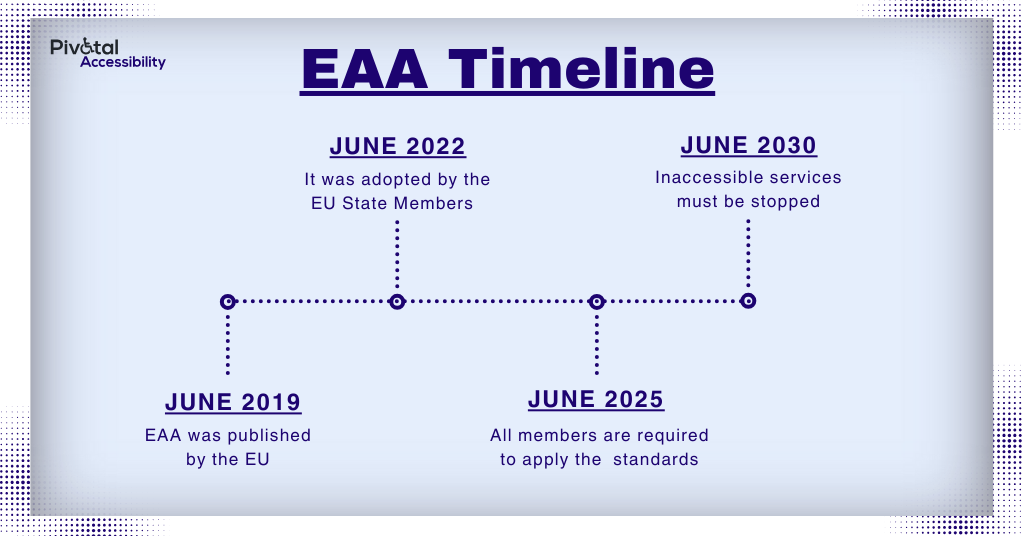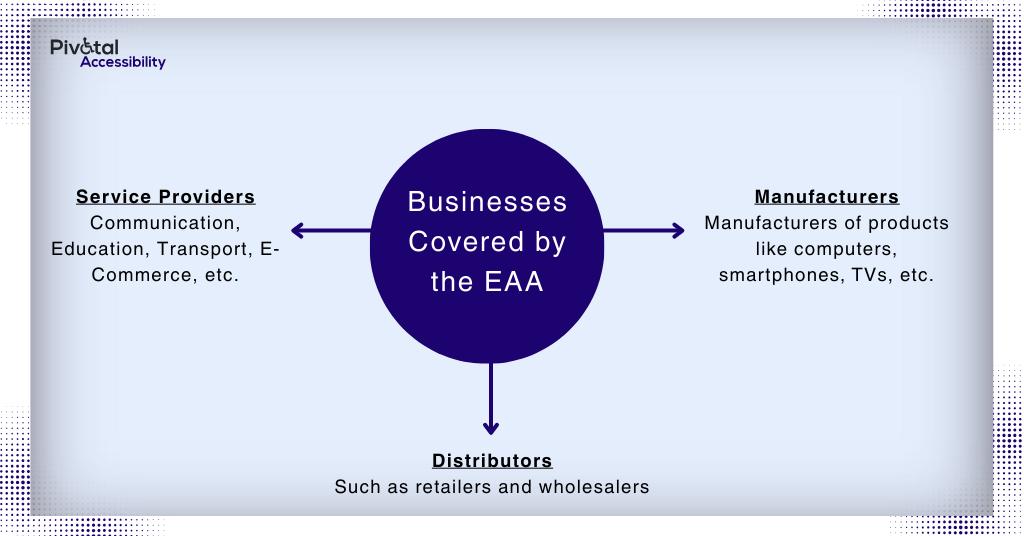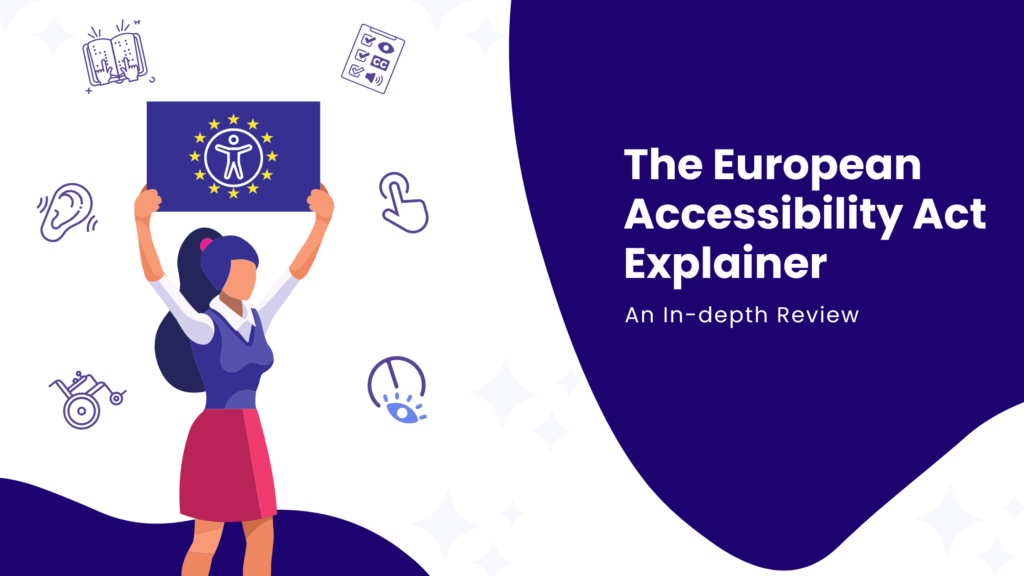With the deadline of the European Accessibility Act on the horizon, digital accessibility is no longer optional as it is increasingly becoming a stringent requirement for public-facing businesses worldwide. You have to comply with accessibility regulations like the ADA, AODA, RPwD Act 2016, if your business is located in the US, UK, Canada, India, etc., or if you plan to expand your business in these regions.
Until now, Europe enforced stringent accessibility regulations, but member states implemented them inconsistently. The lack of a uniform guideline governing accessibility practices across all 27 European Union (EU) states caused this fragmentation.
Therefore, to deal with these irregularities, the European Union (EU) introduced the European Accessibility Act or EAA in 2019. Like most legal directives, the 2019/882 directive of the EU might be hard to understand and implement at your organization to achieve compliance. Our blog will break it down and list out all the important details that you must know to achieve compliance.
What is the European Accessibility Act, or EAA?
The European Union introduced the European Accessibility Act (EAA) in 2019 to enhance accessibility by establishing common standards across member states. This legal directive aims to ensure that everyone, including people with disabilities, can access digital products and services. The act primarily targets the EU, but it has already begun influencing global practices and will likely evolve into a widely accepted international standard.
Benefits of the European Accessibility Act
The EU believes that, besides making the digital world an equitable platform for people with disabilities, the EAA significantly benefits businesses that comply with it. Some of the apparent benefits of the EAA for businesses are:
- The EAA introduced common accessibility standards across the EU, making compliance smooth and cost-effective.
- Compliance with accessibility standards will boost opportunities for businesses by increasing their user base.
- Uniform compliance standards will make compliance easier and mitigate potential legal risks.
- Integrating accessibility practices will help web-based services improve their SEO.
- Accessibility practices also improve general user experience, leading to better conversion rates and customer retention.
EAA will also benefit the demographics of the region by helping them:
- Use everyday items and access essential services involving the digital world.
- Expanding the market of accessibility and bringing down the prices of products and services.
- Making key areas like education, employment, health, etc., accessible and providing opportunities.
Timeline and implementation of the European Accessibility Act

The EU member states adopted the European Accessibility Act as a regulation after it was first introduced in 2019. Here is the detailed timeline of the Act:
- 3 December 2015: The European Commission formally proposed the European Accessibility Act (EAA), aiming to harmonize accessibility requirements for key products/services across the EU.
- 17 April 2019: The European Parliament and Council adopted the EAA as Directive (EU) 2019/882. It was signed in Strasbourg on that date and published in the Official Journal on 7 June 2019 (OJ L 151). The Directive entered into force 20 days after publication (around 27 June 2019).
- 28 June 2022: Deadline for Member States to transpose the EAA into national law. All EU countries had to adopt and publish implementing legislation by this date.
- 28 June 2025: Compliance deadline (application date). From this date, the EAA’s accessibility requirements become applicable across the EU. In practice, after 28 June 2025, all in-scope products and services (including websites and mobile apps) offered in the EU must meet the EAA’s standards. Non-compliant offerings may face enforcement (e.g., withdrawal from the EU market or sales bans) and dissuasive penalties.
- 28 June 2030: End of transitional period. Service providers must, by this data, stop using “legacy” products that predate the EAA’s entry into force. Specifically, until 28 June 2030, businesses could continue using pre-2025 equipment or software for services, and honour contracts begun before 28 June 2025 (for up to 5 years). After 2030, all service delivery must fully comply.
- 28 June 2045: Extended grace for self-service terminals (ATMs, ticket machines, etc.) lawfully in use before 2025. These may remain in use until the end of their useful life (max 20 years), but in any event, must be replaced by this date.
Products and services covered under the European Accessibility Act
Now let’s take a look at the actual products and services covered by the EAA:
- Computers and operating systems.
- E-books.
- E-commerce.
- ATMs, tickets, and check-in machines.
- Smartphones.
- TV equipment.
- Telephone equipment.
- Banking services
- Transport
- Audio-visual media service
Exemptions from the European Accessibility Act
Certain digital products and services are exempted from the EAA. These include:
- Archived websites or websites that will not be updated after 28 June, 2025.
- Content that is not directly controlled by the service provider or user-generated content.
- Content published before 28 June 2025.
- PDFs, Documents, sheets, and other files made before 28 June 2025.
- Online maps and map-related services, unless they are used for navigation.

Does EAA require WCAG Compliance?
The Web Content Accessibility Guidelines (WCAG) are the most widely accepted global standards for ensuring web accessibility. Developed by the World Wide Web Consortium (W3C), WCAG outlines how to make digital content more usable for people with a wide range of disabilities: visual, auditory, cognitive, and motor.
The EAA does not directly mention WCAG, but EU-level technical standards indirectly anchor it to the guidelines. Most notably, the European Standard EN 301 549 incorporates WCAG 2.1 guidelines as the baseline for evaluating the accessibility of digital content and services. Therefore, WCAG plays a foundational role in how organizations can interpret and implement the technical aspects of EAA compliance.
In practice, this means that if your website, mobile app, or digital service meets WCAG 2.1 Level AA, you’re already on the right path toward complying with EAA requirements for digital accessibility. However, the EAA goes beyond web content, it also includes physical products, customer support services, and design processes. Broader European standards like EN 301 549 and EN 17161 address these areas.
EN 301 549
Firstly, to define the technical accessibility requirements for digital products and services, the EAA references the latest version of European standard EN 301 549. The European Standardization Organizations developed this standard to outline accessibility criteria for Information and Communication Technology (ICT) products and services across the EU.
The most current version used for compliance is EN 301 549 Version 3.2.1, which directly incorporates WCAG 2.1 as its foundation for web content accessibility. Organizations align with WCAG because it is globally recognized, helping them ensure both regional and international compatibility. EN 301 549 includes three levels of conformance: A, AA, and AAA, with Level AA being the minimum mandatory level for compliance under the EAA.
EN 17161
Secondly, alongside EN 301 549, the EAA also references EN 17161, a standard focused on ensuring that the design process itself is inclusive. This standard emphasizes “Design for All” principles, aiming to make products, services, and environments accessible to as wide a range of users as possible, including people with disabilities. It encourages organizations to integrate accessibility into every stage of development, promoting long-term inclusive practices beyond digital interfaces.
How should businesses prepare for the European Accessibility Act?
With the EAA set to take full effect from June 28, 2025, companies need to make sure that they are compliant with the standards. Let’s talk about some steps organizations should take to ensure compliance:
- Make sure that their digital products and services are accessible as per the EAA standards and make changes if required.
- Invest in testing products and services to ensure accessibility.
- Develop a strategy to make sure that they are compliant with the EAA within the given time frame.
- Create a mechanism to take feedback on the accessibility of products and services from consumers.
- Train employees to make sure they understand the EAA standards and implement them when working on digital products and services.
- Invest in tools to integrate accessibility in all stages of development going ahead.
- Determine what parts of your digital products and services require attention in terms of accessibility.
Enforcement of the European Accessibility Act
Each EU member state manages the enforcement of the EAA at the national level. They implement the standards, determine effective penalties to ensure compliance, and establish mechanisms for consumers and organizations to file complaints about noncompliance.
Consequences of non-compliance
As per the EU, failure to comply with the EAA may result in significant fines, including the removal of a product/service, to the suspension of an organization’s business. Here is a detailed breakdown of the consequences:
- Financial penalties can range from €5,000 to €600,000.
- Products and services that are non-compliant may be prohibited from being sold in the market, limiting a company’s reach.
- Lacking in terms of accessibility can raise ethical questions and hurt a company’s reputation.
- Non-compliant organizations will face the risk of legal action against them. Citizens and organizations across 27 countries are allowed to take legal action against non-compliance with the EAA.
Businesses can no longer let accessibility be a last-minute priority, and they certainly cannot overlook accessibility after June 2025 if they plan on doing business in or with the EU. They will have to prioritize accessibility from the start to maintain compliance with local laws to mitigate lawsuits.
In conclusion, we understand that complying with the EAA can seem challenging due to the various aspects involved. Therefore, if your organization is starting its accessibility journey or needs assistance to expedite the process before the June 2025 deadline, our team of IAAP-certified professionals is here to help. At Pivotal Accessibility, we offer comprehensive accessibility solutions to ensure your organization meets both local and international accessibility standards. We can help you streamline your efforts to meet the EAA deadline efficiently and cost-effectively. Contact us for customized plans that suit your needs, and we will respond promptly. Let’s work together to create a more equitable and accessible world for everyone.

